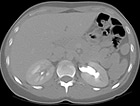


Injecting a nerve toxin to allow the stomach to release food. Researchers are working on new ways of treating gastroparesis, such as: During surgery, the lower part of the stomach may be stapled or bypassed to help improve stomach emptying. If treatment doesn’t help control your nausea, vomiting or malnutrition, you may consider gastroparesis surgery. There is a risk of serious side effects with these medications, so discuss the benefits and risks with your doctor. These medications include metoclopramide (Reglan) and erythromycin. Medications to stimulate the stomach muscles. Anti-emetic medications include prochlorperazine (Compro), diphenhydramine (Benadryl, Unisom) and lorazepam (Ativan). Medications to control nausea and vomiting. Medications to treat gastroparesis may include: The tube is usually temporary and is only used when gastroparesis is severe or when blood sugar levels can’t be controlled by any other method. In these situations, doctors may recommend a feeding tube (jejunostomy tube) be placed in the small intestine.įeeding tubes can be passed through your nose or mouth or directly into your small intestine through your skin. Some people with gastroparesis may be unable to tolerate any food or liquids. Try gentle exercise after you eat, such as going for a walk. If liquids are easier for you to ingest, try soups and pureed foods. A dietitian might suggest that you try to:Įat low-fiber forms of high-fiber foods, such as well-cooked fruits and vegetables rather than raw fruits and vegetables.Ĭhoose mostly low-fat foods, but if you can tolerate them, add small servings of fatty foods to your diet.Īvoid fibrous fruits and vegetables, such as oranges and broccoli, that may cause bezoars. Your doctor may refer you to a dietitian who can work with you to find foods that are easier for you to digest, so that you’re more likely to get enough calories and nutrients from the food you eat. Beyond this, other gastroparesis treatments may include: Changes to your diet For instance, if diabetes is causing your gastroparesis, your doctor can work with you to help you control your diabetes. Treating gastroparesis begins with identifying and treating the underlying condition. Using this instrument, your doctor can view any irregularities in your upper digestive tract and remove tissue samples (biopsy). During an endoscopy exam, your doctor threads a long flexible tube equipped with a tiny camera (endoscope) down your throat and esophagus and into your stomach and duodenum. A laboratory test called a stool antigen test looks for foreign proteins (antigens) associated with H. You exhale into a bag and your doctor uses a special device to detect the radioactive carbon. Your body absorbs the radioactive carbon and expels it when you exhale. pylori infection, the radioactive carbon is released when the solution is broken down in your stomach. During a breath test, you swallow a pill, liquid or pudding that contains radioactive carbon molecules. A blood sample is usually collected by pricking your finger.īreath test. Analysis of a blood sample may reveal evidence of an active or previous H. Tests and procedures used to determine whether you have an H.


 0 kommentar(er)
0 kommentar(er)
